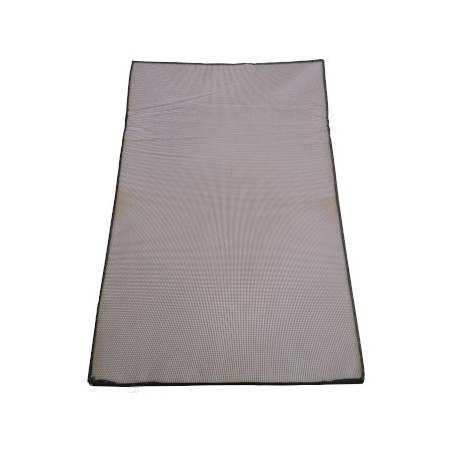Commented article
Niederwerder MC, Stoian A, Rowland R, Dritz SS, Petrovan V, Constance LA, et al. Infectious Dose of African Swine Fever Virus When Consumed Naturally in Liquid or Feed. Emerg Infect Dis. 2019;25(5):891-897. https://dx.doi.org/10.3201/eid2505.181495
Read the article summary
Comment

The African swine fever epidemic that is affecting Central Europe and Asia never fails to surprise us, especially the apparent ease with which some farms have been infected, including some farms with apparent good biosecurity. This is the case for some of the infected industrial farms in Romania or Bulgaria. The fact that the Romanian Official Veterinary Services considered the water from the Danube river as a likely source of infection of one of these large farms, set all the alarm bells ringing, as reviewing literature there was no data about it.
The present article is interesting, as for the first time it establishes what the minimum infective doses should be in water and feed to generate an ASF infection. That contaminated water or feed can carry the infection should come as no surprise, as we have known for years that feeding pigs with contaminated food has been one of the main routes of ASF infection. But I think it is important not to panic and start to think that any feed or water used in a farm can be infecting material, especially if we consider the experience we have in Spain with the disease. To be better understood, I have allowed myself to perform a few small calculations to see what it is the real probability of reaching infecting concentrations in drinking water. To make it more graphic I have taken the example of the theoretically infected farm from the water taken from the Danube. Does anyone know how many infected dead pigs should fall or be thrown into the Danube to get a dose of 101 TCID50? Well, considering the data on the average flow of the Danube: 6500 m3/s and taking into account that the average weight of the pigs thrown into the Danube would be 50 kg and that all the blood present in these (65 ml/ kg weight) was diluted in the water of the Danube and that concentration of virus in blood was the same as detected in cases of an acute infection: 3 x 106 copies/200 microliters (Blome et al., 2013) it would be necessary that every day at least 115 pigs would fell or would be thrown into the river, that all the blood contained in their bodies would be diluted in the drinking water and that this water was not subjected to any disinfection system that could reduce its viral load.
As far as raw materials are concerned and according to the same work, the infectious load should be greater than 105.6 TCID50 so it would seem a less likely route if we think of possible contamination in the source fields, but it can be a factor to take into account if the contamination occurs during storage.
When considering the biosecurity of pig farms, taking into account this study, we will need to consider the sanitization of drinking water, especially where it comes from sources that may have some risk (such as rivers or water channels) and in relation to feed, the most important thing will be to ensure that both suppliers and users have safe storage systems that prevent contact of the raw material/ feed with sources of contamination (such as other animals: rodents, birds, wild boar).
Abstract of the commented article
What are they studying? How was it done? Experimental infection was carried out in 68 healthy crossbreed pigs of around 52 days of age in a biosafety level 3 containment facility in 7 separate replications at the different doses. The source of virus was from spleen collected from pigs acutely infected with ASFV Georgia 2007 (the strain currently circulating in Europe and Asia). The dose of virus was titrated into different dilutions from 100 to 108 TCID50/ml (50% tissue culture infectious dose per millilitre), that were added to 100 ml of liquid media (RPMI) or 100g of complete feed (free from animal based ingredients). The selection of the infectious dose was determined using the continuous reassessment method to adjust ID50 and optimise the dose determination curve. Pigs were feed and water restricted for 10-14 hours to ensure consumption of the spiked liquid or feed. Non-inoculated control pigs were housed with exposed pigs in separate pens. Pigs were exposed to a single dose of ASFV. Based on the single exposure the authors modelled repeated exposures, assuming repeated exposures are independent events. They calculated the infection probability of multiple exposures as 1-(1-p)q, p= single exposure probability and q= number of exposures. Pigs were clinically examined twice daily until euthanasia on day 5 or earlier if clinical signs of ASF were observed. Infection was confirmed with 3 tests: PCR from blood, PCR from spleen or virus isolation from spleen. What are the results and what implications does this paper have? Thirty-two pigs showed evidence of ASF infection (16 positive by virus isolation and PCR of spleen, 8 positive in spleen virus isolation alone, 8 positive on all tests). Overall, the probability of infection increased as the dose increased. The minimum infectious dose of ASFV in liquid was 100 50% tissue culture infectious dose (TCID50), compared with 104 TCID50 in feed. The median infectious dose was 101.0 TCID50 for liquid and 106.8 TCID50 for feed. Table 1. Summary of results for pigs orally exposed to ASFV in liquid or feed to determine the infectious dose of ASFV when consumed naturally
TCID50, 50% tissue culture infectious dose; –, no pigs tested. When multiple exposures were modelled the infection probability increases at all dose levels for both liquid and feed. By 10 exposures with ASFV containing liquid the probability is near 1 at the lowest dose level of 1 TCID50. Conclusion This paper demonstrates that ASFV Georgia 2007 can easily be transmitted orally through natural consumption of both liquid and feed, although higher doses are required for infection in plant-based feed. The low infectious dose of ASFV via drinking should be considered a possible factor for spread of ASF through water. Despite a higher minimum infectious dose in feed compared with liquid, the authors hypothesize that feed may pose a higher risk than water sources because feed delivery is a high frequency event and centralized feed manufacturing uses ingredients of a global origin facilitating contaminated feed to be distributed to large number of pigs farms. |







